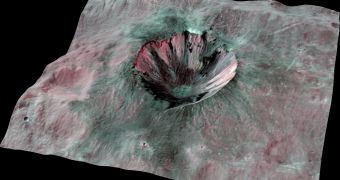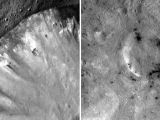NASA's Dawn may have left Vesta already, but the year it spent circling the protoplanet has been fruitful, the images and data it uncovered will continue to fuel research and discoveries for a long time to come.
One of the things that has been puzzling astronomers about Vesta is that, unlike most other bodies in the solar system, Vesta's surface is very white and clean.
A recent study published in the journal Icarus, focused on the dark materials on Vesta's surface, which are scattered around meteorite impacts.
This material, blacker than coal, is found in several places around Vesta, surrounded by otherwise pristine white surfaces, as white as snow.
Normally, the surface of planetary bodies weathers under the effect of the constant bombardment of asteroids and the solar wind.
This is what happens on the Moon, which is much darker on the surface than it is deeper down. When a new meteorite hits, it scatters whiter material around.
On Vesta, it's almost completely the other way around. The dark material is only found around craters. The new study concludes that this dark material is carbonized organic matter, created during the impacts.
In most places, the dark material is covered with the whiter soil, possibly by avalanches and similar phenomena. Analysis of a large crater on Vesta found that the dark material is indeed brought by the asteroids and doesn't originate on Vesta.
This is important for several reasons. For one, the scientists found that this region is very similar in composition to a class of meteorites found on Earth that were believed to originate from Vesta.
Now scientists are sure that these meteorites are indeed from Vesta, opening the door for further analysis of the protoplanet's composition.
Second, it hints to the fact that asteroid impacts brought carbon-rich materials to the early planets and planetoids, creating some of the conditions necessary for life.

 14 DAY TRIAL //
14 DAY TRIAL // 
